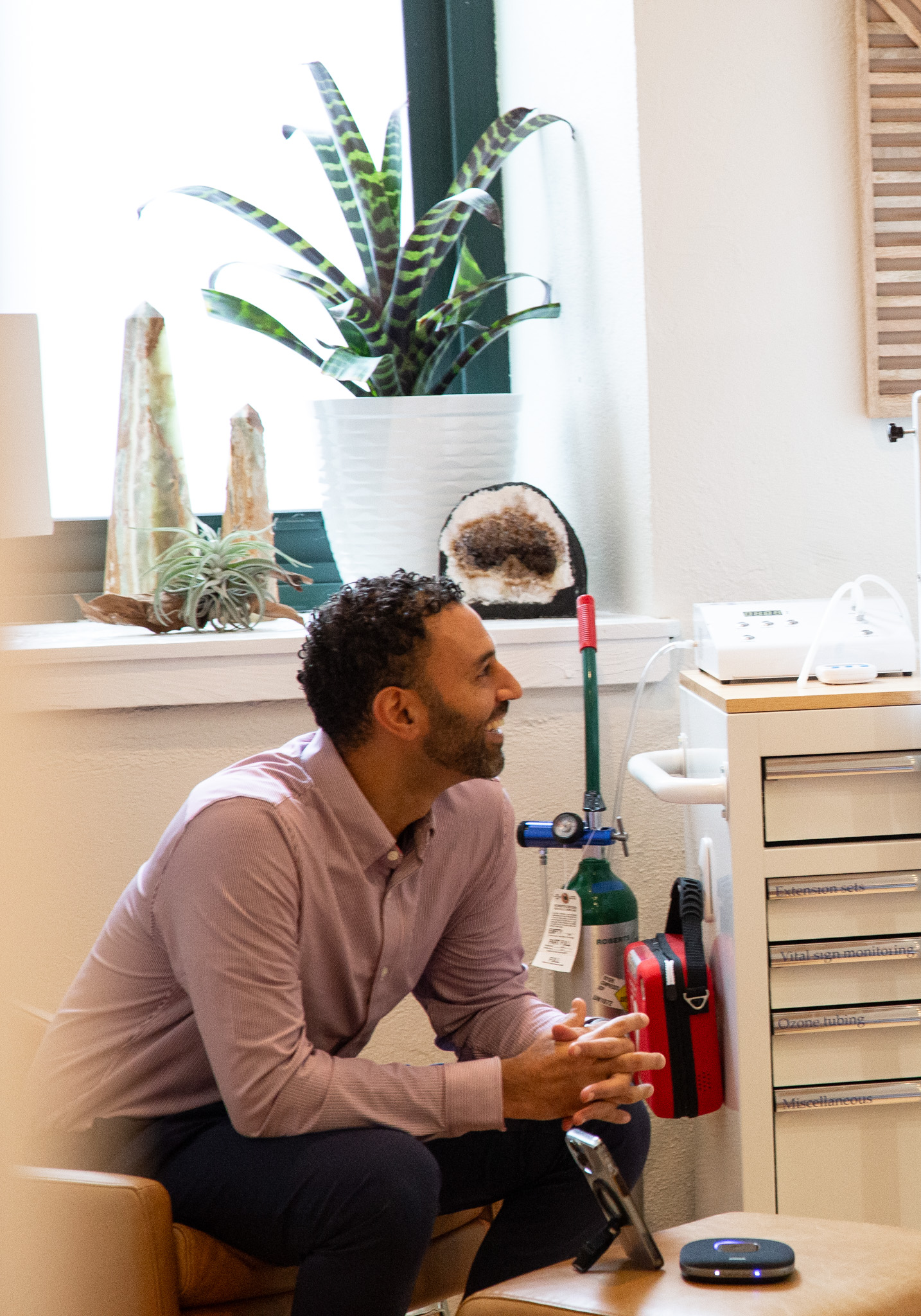
Stem Cell Therapy in Philadelphia
At Meeting Point Health, we offer a comprehensive selection of functional and regenerative treatments designed to meet a variety of health and performance needs.

Treatment Starts at $3,500
TABLE OF CONTENTS

Stem Cell Treatment
At Meeting Point Health in Philadelphia, we believe in empowering your body’s natural ability to heal itself. Stem cell therapy is a cutting-edge, non-surgical treatment designed to repair damaged tissues, reduce inflammation, and support long-term recovery. Whether you’re dealing with chronic pain, joint injuries, or degenerative conditions, our expert team uses an integrative, patient-centered approach to help you regain mobility, alleviate discomfort, and get back to living life on your terms. Explore how stem cell therapy can be the solution you’ve been searching for—because you deserve lasting relief and optimal health.
What is Stem Cell Therapy?
Stem cell therapy is a type of regenerative treatments used in medicine that can help improve the healing of orthopedic injuries, such as osteoarthritis or tendonitis. Stem cells are undifferentiated cells that have the ability to become specific and specialized tissue where they are needed.
Where do Stem Cells come from?
How are allogeneic stem cells harvested?
Types of Stem Cell Therapy
Amniotic stem cell therapy utilizes the growth factors and stem cells found within the clear amniotic fluid that surrounds a growing fetus in the uterus during pregnancy. This technique is safe and can be used to treat numerous health conditions.
Placental tissue matrix stem cells are derived from amniotic tissues and are used to reduce inflammation, minimize scar tissue, and support the healing of soft tissue in areas of injury.
Cord blood stem cells can also be collected from the umbilical cord and placenta after a baby is born. This source is rich in blood cell precursors and is often used to treat immune deficiencies, various types of cancer, and certain genetic disorders.
Exosomes are important carrier vesicles that are generated by all types of cells and are responsible for communication between cells. Exosomes are a vital aspect of cell biology and carry growth factors, nucleic acids, proteins, lipids, and metabolites, which travel through the body and are released into the blood to aid in cell signaling.
Wharton’s jelly stem cells (WJSCs) are a type of mesenchymal stem cell (MSC) found in the gelatinous substance within the umbilical cord, known as Wharton’s jelly. These stem cells are considered valuable because they possess characteristics similar to other MSCs, including the ability to differentiate into various cell types and to modulate immune responses. They exhibit properties such as self-renewal and multipotency, meaning they can give rise to different cell types like bone, cartilage, and fat cells. Additionally, they have low immunogenicity, making them suitable for injection or infusion.
Orthopedic Conditions Treated by Stem Cell Therapy in Philadelphia
At Meeting Point Health, we take a comprehensive and personalized approach to care. Stem cell therapy can be a beneficial form of regenerative medicine for numerous orthopedic conditions and injuries. Below are some of the most common indications for stem cell therapy.
Contact Meeting Point Health today to schedule your personalized consultation and start your journey to relief. Your path to recovery begins here!
Arthritis is inflammation of the joint, where two bones are connected. This condition causes joint stiffness, pain, and swelling, which limits the individual’s range of motion and physical activity.
Sports injuries can be acute or chronic in nature and vary in severity, method of injury, and expected healing process. Injuries can be caused by long periods of overuse with activity or sudden injury with direct stress or force.
There are many conditions involving tendons or the structure that helps to connect your muscles to your bones. Tendinopathies are a response to overuse and result in pain and inflammation of the specific tendon.
The term non-union describes any fracture that has failed to heal after an extended period of time, likely due to inadequate stability or blood flow to the area. The treatments for this type of injury are limited and often include surgery, bone grafting, and immobilization.
A tear to the meniscus is typically the result of forceful rotation or twisting of the knee, sometimes resulting in serious joint pain but always threatening the integrity of the musculoskeletal system. There are different types and severity of tears, with some able to heal on their own and some requiring treatments for proper healing.
Spinal discs act as cushions between vertebrae in the spine. As we age, the spinal disks go through normal wear and tear, get thinner, and may even develop small tears, resulting in degenerative disk disease. The most common symptom is pain that varies in location, severity, and with certain movements.
Osteonecrosis or avascular necrosis is caused by disrupted blood flow to the bone, resulting in the death of the bone tissue. This will eventually result in the bone’s breakdown and the joint’s collapse. This can occur in any large joint but is most common in the shoulder and hip.
How does stem cell therapy work?
Stem cells are also known as mesenchymal stem cells and have the unique property of being able to develop into different types of cells. When they are injected into areas of injury, stem cells help to accelerate the healing process by regenerating the key components necessary to restore function to the joint.
How to prepare for stem cell therapy?
It is important to properly prepare your body before undergoing stem cell therapy. One week before your procedure, you must avoid taking any NSAID medications, including Aspirin, Tylenol, Motrin, Advil, or Aleve. In the days leading up to your procedure, drink plenty of water, preferably 64 oz per day, to ensure adequate hydration.
What is post-procedure recovery like?
The average recovery time post-procedure can dramatically differ depending on the condition being treated and the patient’s underlying health status. Most patients will experience minimal downtime after the procedure and may return to work within a day or two, depending on their occupation.
Patients should expect to limit strenuous activity or exercise for the few weeks following the procedure. In addition, patients should avoid physical manipulation of the joint or area of injection.
Soul-Centered Healthcare As a Catalyst For Change
Many people suffer with undiagnosed or misdiagnosed conditions and simply don’t know what’s wrong with them or what will help. We understand what it’s like to feel trapped in a body that is not working for you! At Meeting Point Health, we find the root cause and use a proven, integrative approach that gets results. As highly trained pioneers in functional and regenerative medicine, we’ve helped thousands of patients take control of their health.
OUR PATIENTS FIND RELIEF HERE
Our Patients Find Relief Here
EXCELLENT
We’re here to answer all of your questions
FAQS about stem cell therapy
Schedule a call with one of our onboarding specialists today so they can answer all of your questions.
How much does stem cell therapy cost?
Starts at $3,500.
How do umbilical cord 'stem cells' work?
They inhibit inflammation, modulate the immune system, and stimulate tissue regeneration.
Will umbilical cord 'stem cells' cause a graft vs. host reaction?
No, studies support that umbilical cord stem cells do not cause a GVH response.
Can I split the contents of a 'stem cell' vial into different regions of the body?
Yes, you can split the contents if medically appropriate, but not among different patients due to regulatory reasons.
Do 'stem cells' duplicate themselves in the body?
No, they do not duplicate in the body but can in a lab setting.
Do 'stem cells' cause cancer or cause cancer to grow?
Studies suggest they neither cause nor promote cancer growth.
Are umbilical cord cells the same as amniotic fluid?
No, umbilical cord cells contain live nucleated cells, while amniotic fluid must be processed and doesn’t contain live cells.
Are live nucleated cells important?
Yes, they produce anti-inflammatory and regenerative components, unlike processed amniotic fluid.
Are there other 'stem cell' products with live nucleated cells?
Yes, bone marrow and adipose-derived stem cells also contain live nucleated cells.
Do you ever use an aborted fetus?
No, we only use donated umbilical cord from live, healthy births.
Is DNA testing necessary?
No, the cells do not penetrate the nucleus of recipient cells, so DNA testing isn’t necessary.
Is HLA matching necessary?
No, the product doesn’t require HLA matching due to very low levels of HLA_DR, which causes negative reactions.
Does age matter?
Yes, younger umbilical cord cells duplicate faster and produce more effective growth factors compared to older cells from autogenic sources such as bone marrow or adipose tissue.
Are there specific numbers of cells necessary to treat different problems?
Yes, there are recommended cell counts for treating various conditions.
How are umbilical cord 'stem cells' processed and are they safe?
The umbilical cord is processed according to AATB regulations. Mothers may choose to store or donate the cord. Donors undergo medical and social history review. The cord is clamped during a cesarean section, then processed and sent for testing. Only after passing safety tests are the processed stem cells available.
Is 'stem cell' use ethical?
We use stem cells from umbilical and placenta cord tissue from healthy live births that would otherwise be destroyed, We absolutely do not use embryonic tissue. Autogenic sources such as bone marrow and adipose tissues from the patients own body are laborious and painful procedures without significantly better results.
Are umbilical cord 'stem cells' from another person safe?
Yes, they are safe. Red blood cell components are removed during processing, and the cells are immature and do not react like adult cells.
Are umbilical cord ‘stem cells’ FDA approved?
No, they’re considered experimental and not FDA approved.
Is it normal to have an inflammatory response after the injection?
Yes, it’s common and indicates the cells are working.
Is an inflammatory response necessary for a good outcome?
No, it’s not necessary, and there’s no exact explanation for why some people experience it.
Can the patient take NSAIDs or steroids?
No, it is best to avoid NSAIDs and steroids 2 weeks before and after the injection to optimize the process.
Can I take 'stem cells' with a biologic?
Biologics may diminish the overall effect of stem cells, as they inhibit the immune system.
Are some growth factors more concentrated in PRP than umbilical cord cells?
Initially yes, but umbilical cord cells continue to produce these growth factors for much longer periods of time.
What activity level can I have after the injection?
It’s advised not to increase activity level beyond pre-injection levels for three months to allow the cells to modulate inflammation and stimulate regeneration.
Should I have physical therapy after the injection?
Yes, however if you opt for physical therapy, focus on exercises that don’t stress the injected joint.
Where do I get Stem Cell Therapy in Philadelphia
We suggest you schedule your new Patient Consultation which will be about 30-90 minutes. Please call for pricing or schedule a call with an intake coordinator.
Does Meeting Point Health accept insurance?
Meeting Point Health does not accept insurance.
Our practitioners and staff fully understand and empathize with the challenges that patients face as they make financial decisions for proper health care. Our practice is very different from a conventional medical practice in many ways, but the time spent with each patient is usually 30-90 minutes. Visits with a physician covered by insurance generally allow for less than 10 minutes in total! Conventional medical practices that take insurance maintain brief office visits and high patient loads for this reason. We cannot provide the expert care that every one of our patients deserves under those circumstances.
Insurance also dictates the types of treatments and order of treatments patients can receive for a particular condition.
Opting out of insurance allows the patient and the doctor to maintain their medical autonomy, which is imperative to ensure you get the right treatment at the right time and the right dose.
Can I get an insurance reimbursement?
How do I get started with Meeting Point Health?
To start your journey to relief, schedule a consultation with our team. During your initial visit, we’ll assess your medical history, perform a thorough evaluation, and develop a customized treatment plan to address your specific needs. Click to schedule a free discovery call with one of our Patient Onboarding Specialists today!

